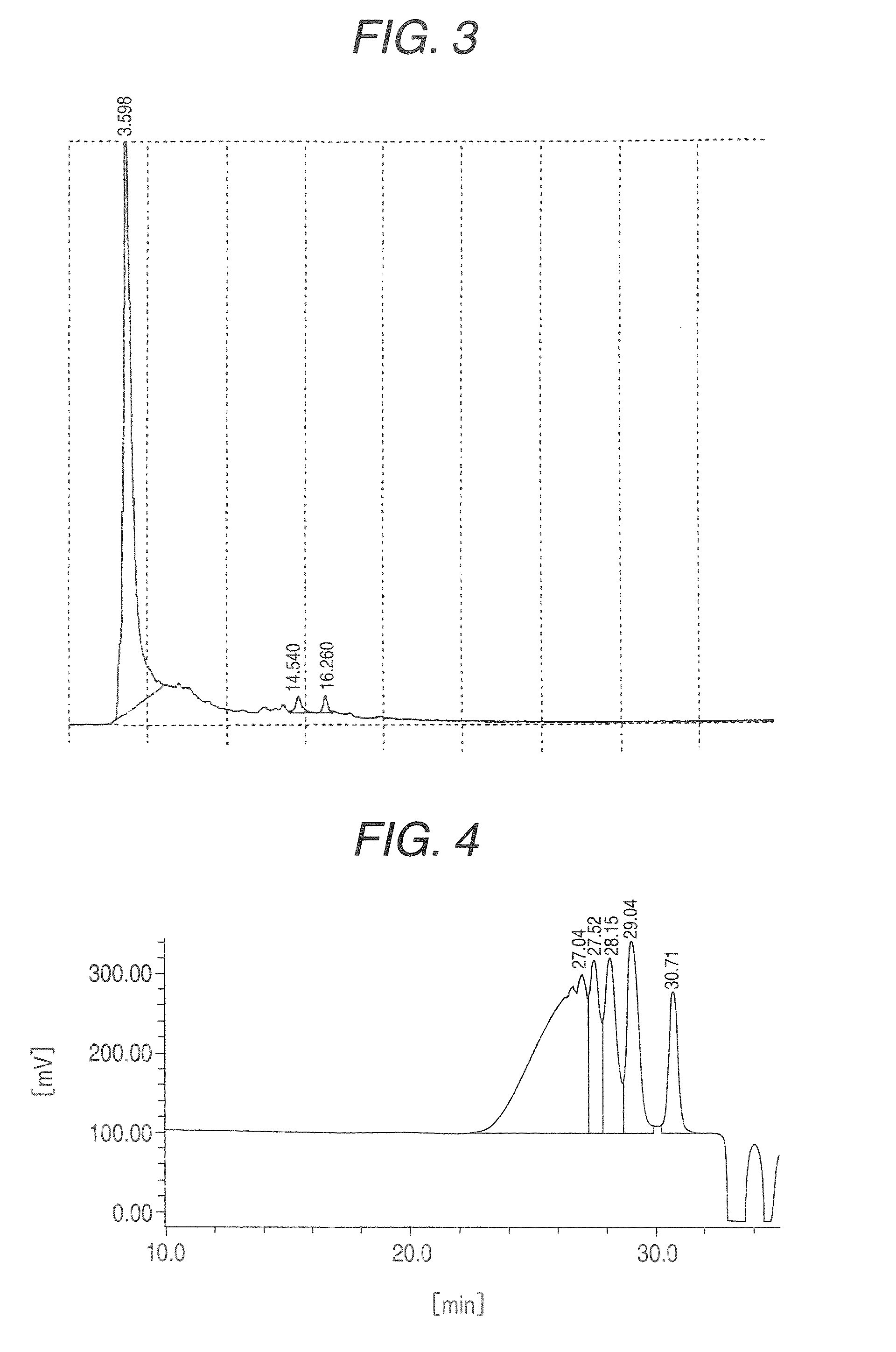Ketone-modified resorcinol-formalin resin
a technology of resorcinol and formalin, which is applied in the direction of aldehyde/ketone condensation polymer adhesives, adhesive types, adhesives, etc., can solve the problems of reducing the work environment, and reducing the adhesive force, so as to achieve the effect of long-term stability of the water dispersion system
- Summary
- Abstract
- Description
- Claims
- Application Information
AI Technical Summary
Benefits of technology
Problems solved by technology
Method used
Image
Examples
example 1
[0039]After 280 g of water and 523.6 g of resorcinol were placed in a 2 L flask made of glass and the whole dissolved at 50° C., 1.2 g of p-toluenesulfonic acid was charged into the reaction vessel. While the reaction system was maintained at 120 to 125° C., 224.0 g of 37% formalin (molar ratio of formaldehyde / resorcinol=0.58) was added dropwise over a period of 300 minutes and, after the completion of the dropwise addition, the mixture was further stirred for 60 minutes to cause a reaction to proceed. After the temperature of the reaction system was cooled to room temperature, 792 mL of toluene was added to a neutralized solution neutralized with 0.7 g of 25% ammonia water, followed by extraction. The extraction step was repeated four times and 524 g of water was charged. After azeotropic distillation, the residue was cooled to obtain 793 g of a resorcinol-formalin condensation liquid (content of resorcinol: about 8%, solid content: 444 g) (resin before ketone-modification). After ...
example 2
[0055]After 280 g of water and 523.6 g of resorcinol were placed in a 2 L flask made of glass and the whole dissolved at 50° C., 1.2 g of p-toluenesulfonic acid was charged into the reaction vessel. While the reaction system was maintained at 120 to 125° C., 204.6 g of 37% formalin (molar ratio of formaldehyde / resorcinol=0.53) was added dropwise over a period of 300 minutes and, after the completion of the dropwise addition, the mixture was further stirred for 60 minutes to cause a reaction to proceed. After the temperature of the reaction system was cooled to room temperature, 916 mL of toluene was added to a neutralized solution neutralized with 0.7 g of 25% ammonia water, followed by extraction. The extraction step was repeated four times and 524 g of water was charged. After azeotropic distillation, the residue was cooled to obtain 742 g of a resorcinol-formalin condensation liquid (content of resorcinol: about 8%, solid content: 415 g) (resin before ketone-modification). After ...
example 3
[0057]After 280 g of water and 523.6 g of resorcinol were placed in a 2 L flask made of glass and the whole dissolved at 50° C., 1.2 g of p-toluenesulfonic acid was charged into the reaction vessel. While the reaction system was maintained at 120 to 125° C., 250.9 g of 37% formalin (molar ratio of formaldehyde / resorcinol=0.65) was added dropwise over a period of 300 minutes and, after the completion of the dropwise addition, the mixture was further stirred for 60 minutes to cause a reaction to proceed. After the temperature of the reaction system was cooled to room temperature, 720 mL of toluene was added to a neutralized solution neutralized with 0.7 g of 25% ammonia water, followed by extraction. The extraction step was repeated four times and 524 g of water was charged. After azeotropic distillation, the residue was cooled to obtain 851 g of a resorcinol-formalin condensation liquid (content of resorcinol: about 8%, solid content: 477 g) (resin before ketone-modification). After ...
PUM
| Property | Measurement | Unit |
|---|---|---|
| Temperature | aaaaa | aaaaa |
| Temperature | aaaaa | aaaaa |
| Fraction | aaaaa | aaaaa |
Abstract
Description
Claims
Application Information
 Login to View More
Login to View More - R&D
- Intellectual Property
- Life Sciences
- Materials
- Tech Scout
- Unparalleled Data Quality
- Higher Quality Content
- 60% Fewer Hallucinations
Browse by: Latest US Patents, China's latest patents, Technical Efficacy Thesaurus, Application Domain, Technology Topic, Popular Technical Reports.
© 2025 PatSnap. All rights reserved.Legal|Privacy policy|Modern Slavery Act Transparency Statement|Sitemap|About US| Contact US: help@patsnap.com



